NRSG258 Case Study: Post-Op Care for Adrenal Tumor - Susan Summers
VerifiedAdded on 2023/06/14
|9
|2441
|445
Case Study
AI Summary
This case study details the etiology, pathophysiology, and post-operative care for Susan Summers, a 40-year-old female with Cushing's syndrome due to a benign adrenal tumor. It discusses the hormonal imbalances, symptoms like obesity and diabetes, and the impact of the tumor on adrenal gland function. Post-operative conditions, including respiration rate, blood pressure, pulse, and urine output, are analyzed, along with necessary healthcare interventions involving nurses, psychologists, and social workers. The case emphasizes the importance of managing cortisol levels and providing comprehensive care for patients with Cushing's syndrome, highlighting the need for early intervention and professional support during recovery. Desklib offers a wealth of resources, including solved assignments and past papers, to aid students in their studies.
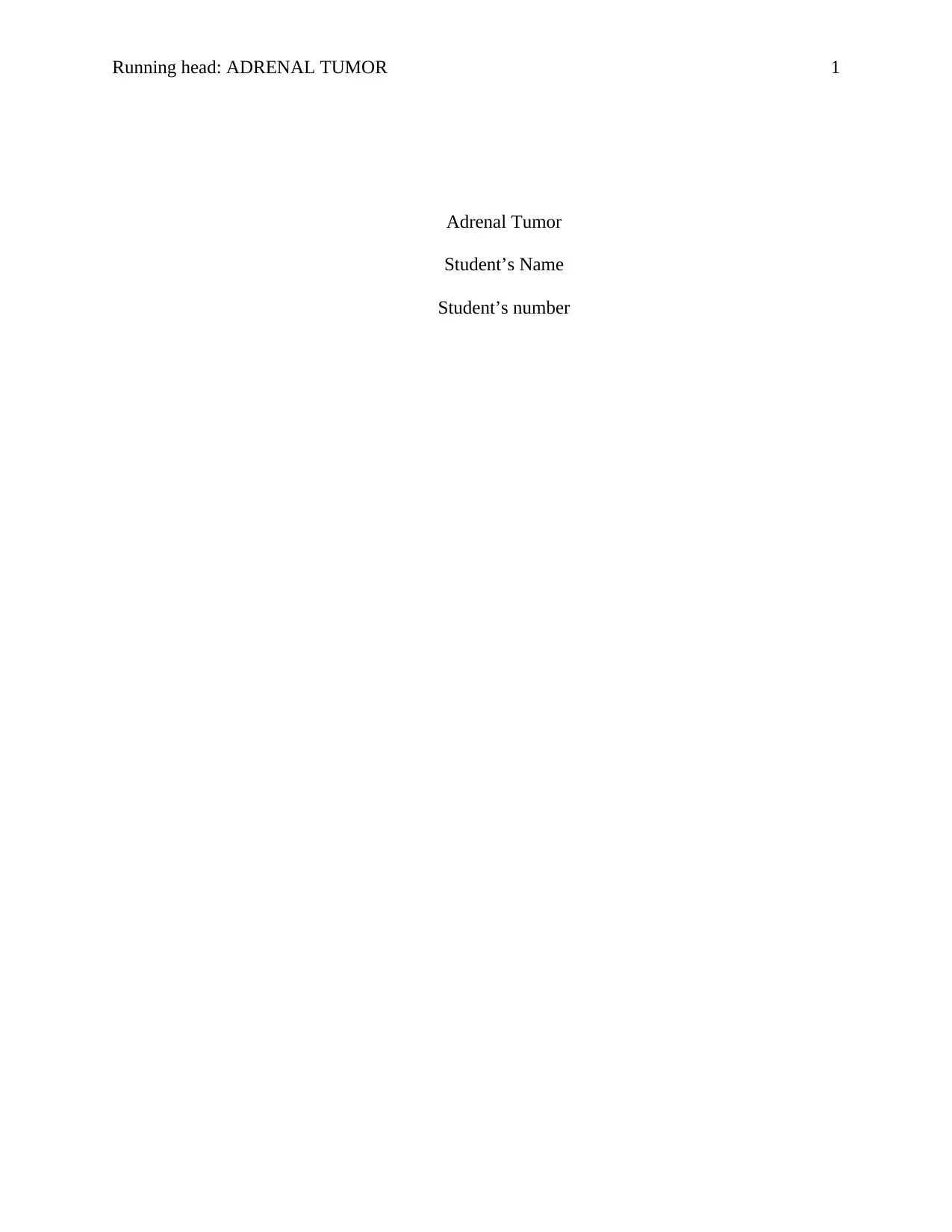
Running head: ADRENAL TUMOR 1
Adrenal Tumor
Student’s Name
Student’s number
Adrenal Tumor
Student’s Name
Student’s number
Secure Best Marks with AI Grader
Need help grading? Try our AI Grader for instant feedback on your assignments.
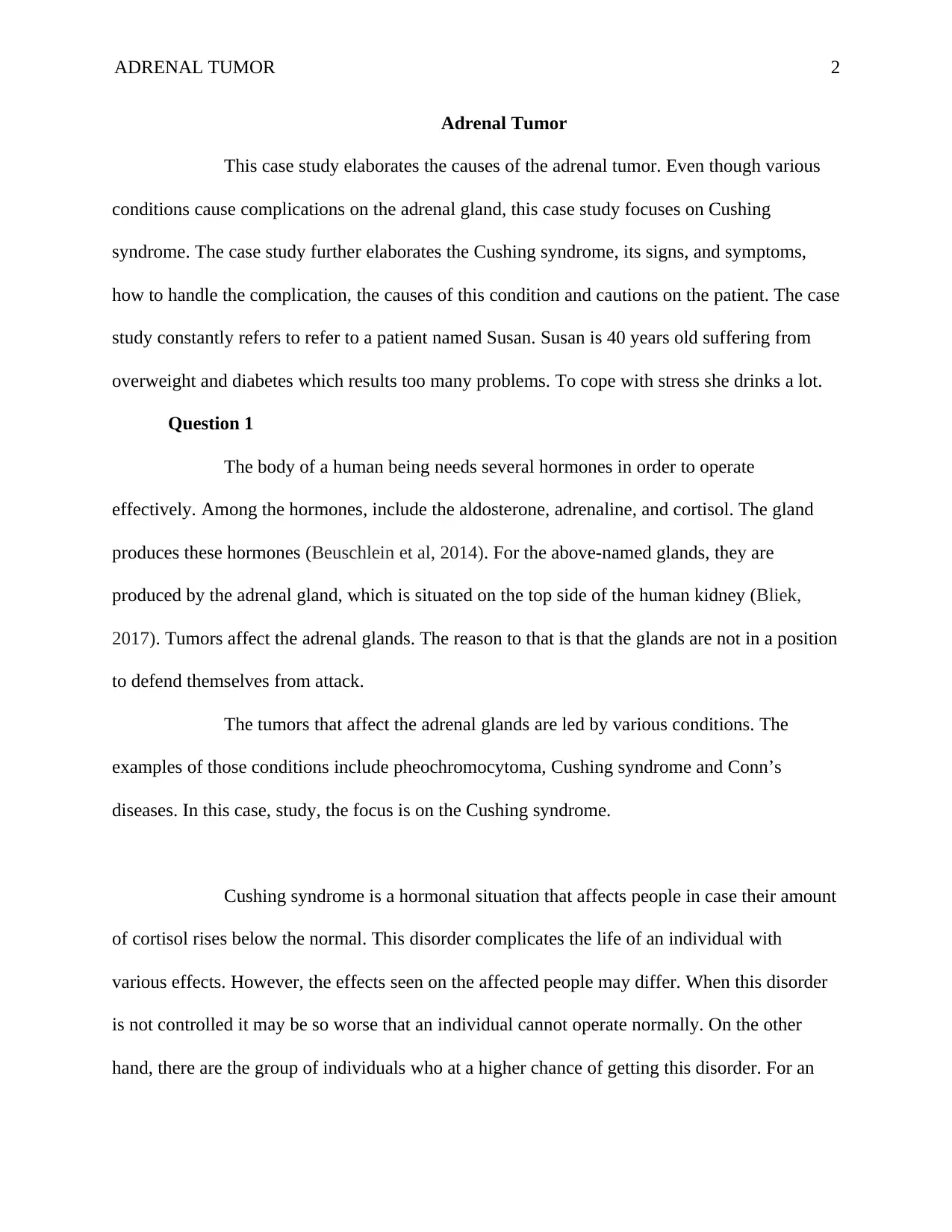
ADRENAL TUMOR 2
Adrenal Tumor
This case study elaborates the causes of the adrenal tumor. Even though various
conditions cause complications on the adrenal gland, this case study focuses on Cushing
syndrome. The case study further elaborates the Cushing syndrome, its signs, and symptoms,
how to handle the complication, the causes of this condition and cautions on the patient. The case
study constantly refers to refer to a patient named Susan. Susan is 40 years old suffering from
overweight and diabetes which results too many problems. To cope with stress she drinks a lot.
Question 1
The body of a human being needs several hormones in order to operate
effectively. Among the hormones, include the aldosterone, adrenaline, and cortisol. The gland
produces these hormones (Beuschlein et al, 2014). For the above-named glands, they are
produced by the adrenal gland, which is situated on the top side of the human kidney (Bliek,
2017). Tumors affect the adrenal glands. The reason to that is that the glands are not in a position
to defend themselves from attack.
The tumors that affect the adrenal glands are led by various conditions. The
examples of those conditions include pheochromocytoma, Cushing syndrome and Conn’s
diseases. In this case, study, the focus is on the Cushing syndrome.
Cushing syndrome is a hormonal situation that affects people in case their amount
of cortisol rises below the normal. This disorder complicates the life of an individual with
various effects. However, the effects seen on the affected people may differ. When this disorder
is not controlled it may be so worse that an individual cannot operate normally. On the other
hand, there are the group of individuals who at a higher chance of getting this disorder. For an
Adrenal Tumor
This case study elaborates the causes of the adrenal tumor. Even though various
conditions cause complications on the adrenal gland, this case study focuses on Cushing
syndrome. The case study further elaborates the Cushing syndrome, its signs, and symptoms,
how to handle the complication, the causes of this condition and cautions on the patient. The case
study constantly refers to refer to a patient named Susan. Susan is 40 years old suffering from
overweight and diabetes which results too many problems. To cope with stress she drinks a lot.
Question 1
The body of a human being needs several hormones in order to operate
effectively. Among the hormones, include the aldosterone, adrenaline, and cortisol. The gland
produces these hormones (Beuschlein et al, 2014). For the above-named glands, they are
produced by the adrenal gland, which is situated on the top side of the human kidney (Bliek,
2017). Tumors affect the adrenal glands. The reason to that is that the glands are not in a position
to defend themselves from attack.
The tumors that affect the adrenal glands are led by various conditions. The
examples of those conditions include pheochromocytoma, Cushing syndrome and Conn’s
diseases. In this case, study, the focus is on the Cushing syndrome.
Cushing syndrome is a hormonal situation that affects people in case their amount
of cortisol rises below the normal. This disorder complicates the life of an individual with
various effects. However, the effects seen on the affected people may differ. When this disorder
is not controlled it may be so worse that an individual cannot operate normally. On the other
hand, there are the group of individuals who at a higher chance of getting this disorder. For an
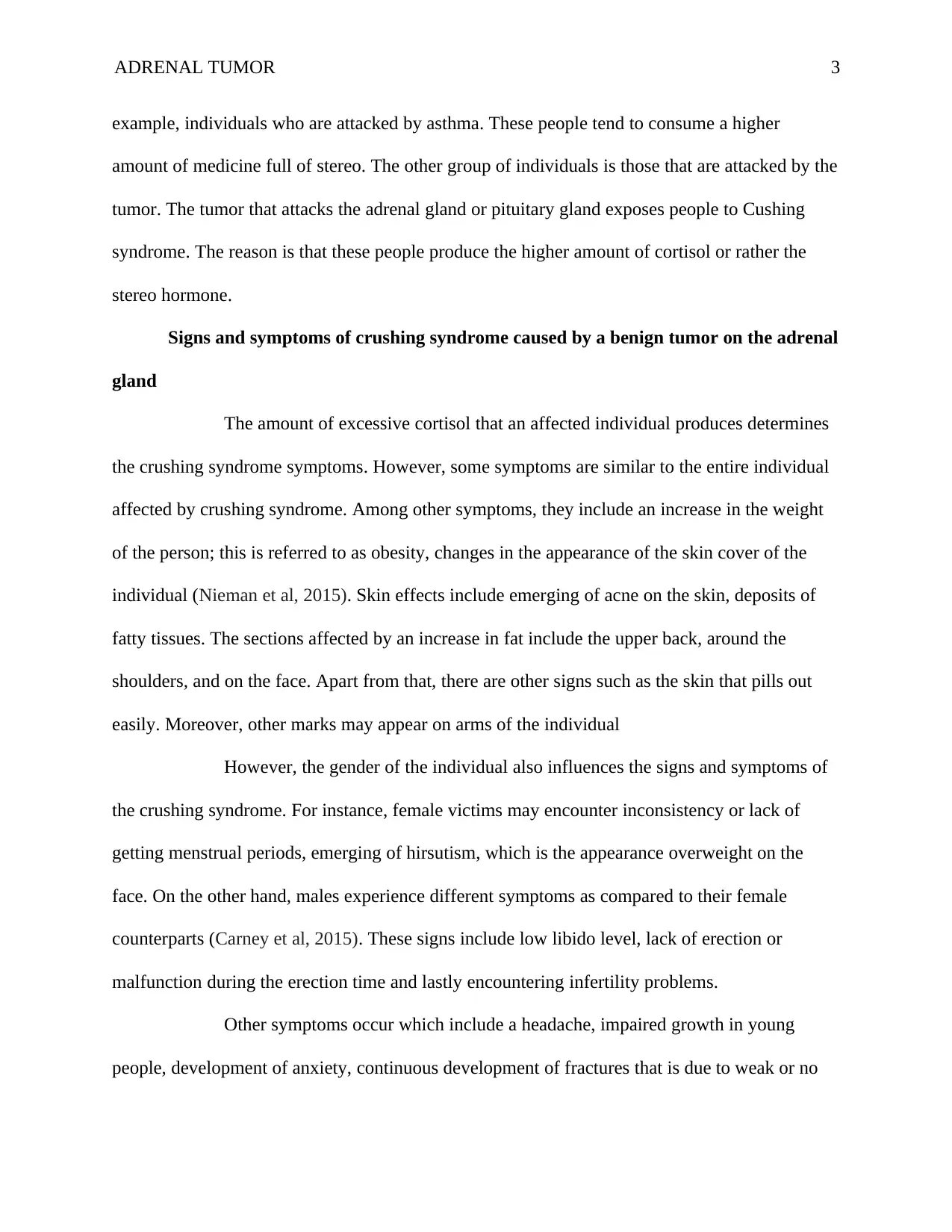
ADRENAL TUMOR 3
example, individuals who are attacked by asthma. These people tend to consume a higher
amount of medicine full of stereo. The other group of individuals is those that are attacked by the
tumor. The tumor that attacks the adrenal gland or pituitary gland exposes people to Cushing
syndrome. The reason is that these people produce the higher amount of cortisol or rather the
stereo hormone.
Signs and symptoms of crushing syndrome caused by a benign tumor on the adrenal
gland
The amount of excessive cortisol that an affected individual produces determines
the crushing syndrome symptoms. However, some symptoms are similar to the entire individual
affected by crushing syndrome. Among other symptoms, they include an increase in the weight
of the person; this is referred to as obesity, changes in the appearance of the skin cover of the
individual (Nieman et al, 2015). Skin effects include emerging of acne on the skin, deposits of
fatty tissues. The sections affected by an increase in fat include the upper back, around the
shoulders, and on the face. Apart from that, there are other signs such as the skin that pills out
easily. Moreover, other marks may appear on arms of the individual
However, the gender of the individual also influences the signs and symptoms of
the crushing syndrome. For instance, female victims may encounter inconsistency or lack of
getting menstrual periods, emerging of hirsutism, which is the appearance overweight on the
face. On the other hand, males experience different symptoms as compared to their female
counterparts (Carney et al, 2015). These signs include low libido level, lack of erection or
malfunction during the erection time and lastly encountering infertility problems.
Other symptoms occur which include a headache, impaired growth in young
people, development of anxiety, continuous development of fractures that is due to weak or no
example, individuals who are attacked by asthma. These people tend to consume a higher
amount of medicine full of stereo. The other group of individuals is those that are attacked by the
tumor. The tumor that attacks the adrenal gland or pituitary gland exposes people to Cushing
syndrome. The reason is that these people produce the higher amount of cortisol or rather the
stereo hormone.
Signs and symptoms of crushing syndrome caused by a benign tumor on the adrenal
gland
The amount of excessive cortisol that an affected individual produces determines
the crushing syndrome symptoms. However, some symptoms are similar to the entire individual
affected by crushing syndrome. Among other symptoms, they include an increase in the weight
of the person; this is referred to as obesity, changes in the appearance of the skin cover of the
individual (Nieman et al, 2015). Skin effects include emerging of acne on the skin, deposits of
fatty tissues. The sections affected by an increase in fat include the upper back, around the
shoulders, and on the face. Apart from that, there are other signs such as the skin that pills out
easily. Moreover, other marks may appear on arms of the individual
However, the gender of the individual also influences the signs and symptoms of
the crushing syndrome. For instance, female victims may encounter inconsistency or lack of
getting menstrual periods, emerging of hirsutism, which is the appearance overweight on the
face. On the other hand, males experience different symptoms as compared to their female
counterparts (Carney et al, 2015). These signs include low libido level, lack of erection or
malfunction during the erection time and lastly encountering infertility problems.
Other symptoms occur which include a headache, impaired growth in young
people, development of anxiety, continuous development of fractures that is due to weak or no
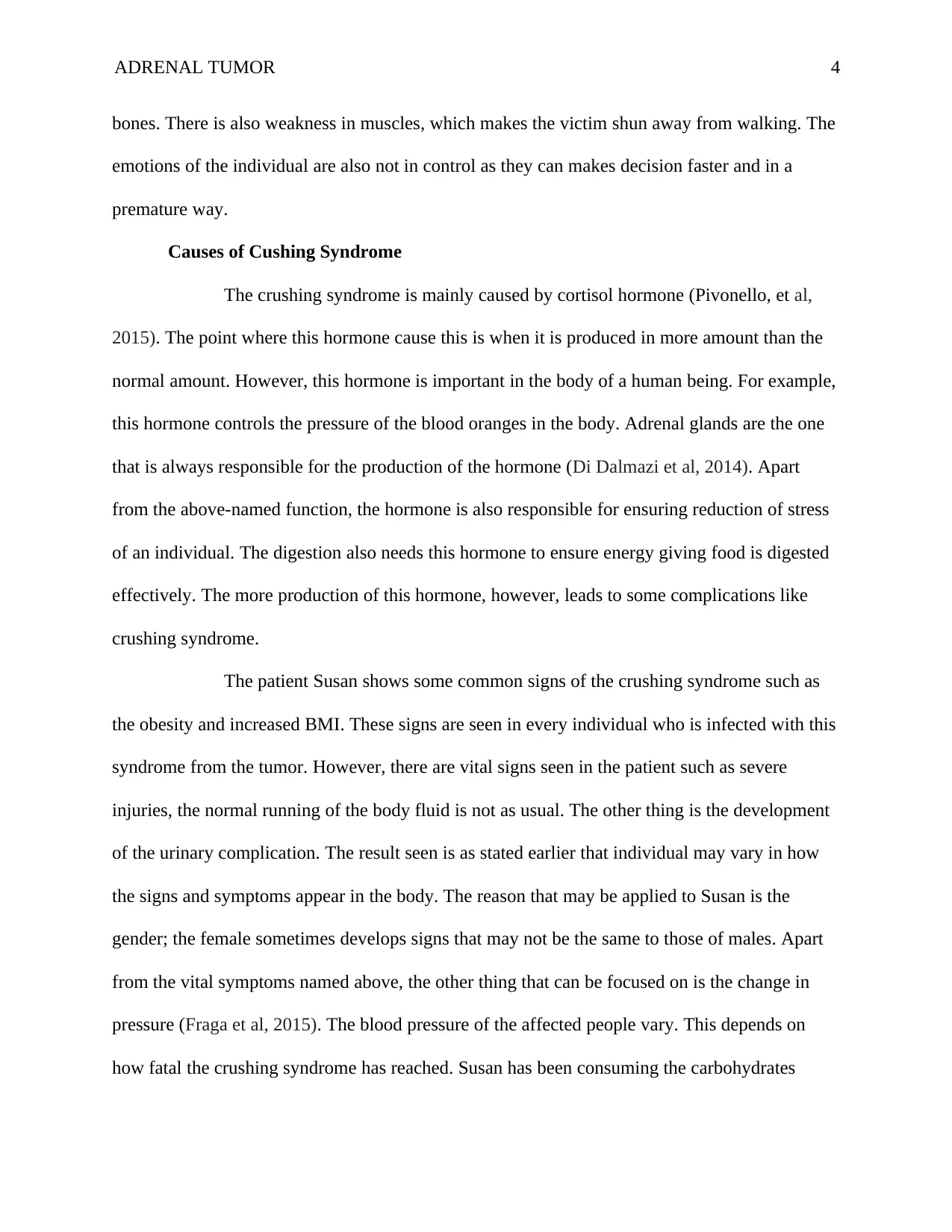
ADRENAL TUMOR 4
bones. There is also weakness in muscles, which makes the victim shun away from walking. The
emotions of the individual are also not in control as they can makes decision faster and in a
premature way.
Causes of Cushing Syndrome
The crushing syndrome is mainly caused by cortisol hormone (Pivonello, et al,
2015). The point where this hormone cause this is when it is produced in more amount than the
normal amount. However, this hormone is important in the body of a human being. For example,
this hormone controls the pressure of the blood oranges in the body. Adrenal glands are the one
that is always responsible for the production of the hormone (Di Dalmazi et al, 2014). Apart
from the above-named function, the hormone is also responsible for ensuring reduction of stress
of an individual. The digestion also needs this hormone to ensure energy giving food is digested
effectively. The more production of this hormone, however, leads to some complications like
crushing syndrome.
The patient Susan shows some common signs of the crushing syndrome such as
the obesity and increased BMI. These signs are seen in every individual who is infected with this
syndrome from the tumor. However, there are vital signs seen in the patient such as severe
injuries, the normal running of the body fluid is not as usual. The other thing is the development
of the urinary complication. The result seen is as stated earlier that individual may vary in how
the signs and symptoms appear in the body. The reason that may be applied to Susan is the
gender; the female sometimes develops signs that may not be the same to those of males. Apart
from the vital symptoms named above, the other thing that can be focused on is the change in
pressure (Fraga et al, 2015). The blood pressure of the affected people vary. This depends on
how fatal the crushing syndrome has reached. Susan has been consuming the carbohydrates
bones. There is also weakness in muscles, which makes the victim shun away from walking. The
emotions of the individual are also not in control as they can makes decision faster and in a
premature way.
Causes of Cushing Syndrome
The crushing syndrome is mainly caused by cortisol hormone (Pivonello, et al,
2015). The point where this hormone cause this is when it is produced in more amount than the
normal amount. However, this hormone is important in the body of a human being. For example,
this hormone controls the pressure of the blood oranges in the body. Adrenal glands are the one
that is always responsible for the production of the hormone (Di Dalmazi et al, 2014). Apart
from the above-named function, the hormone is also responsible for ensuring reduction of stress
of an individual. The digestion also needs this hormone to ensure energy giving food is digested
effectively. The more production of this hormone, however, leads to some complications like
crushing syndrome.
The patient Susan shows some common signs of the crushing syndrome such as
the obesity and increased BMI. These signs are seen in every individual who is infected with this
syndrome from the tumor. However, there are vital signs seen in the patient such as severe
injuries, the normal running of the body fluid is not as usual. The other thing is the development
of the urinary complication. The result seen is as stated earlier that individual may vary in how
the signs and symptoms appear in the body. The reason that may be applied to Susan is the
gender; the female sometimes develops signs that may not be the same to those of males. Apart
from the vital symptoms named above, the other thing that can be focused on is the change in
pressure (Fraga et al, 2015). The blood pressure of the affected people vary. This depends on
how fatal the crushing syndrome has reached. Susan has been consuming the carbohydrates
Secure Best Marks with AI Grader
Need help grading? Try our AI Grader for instant feedback on your assignments.
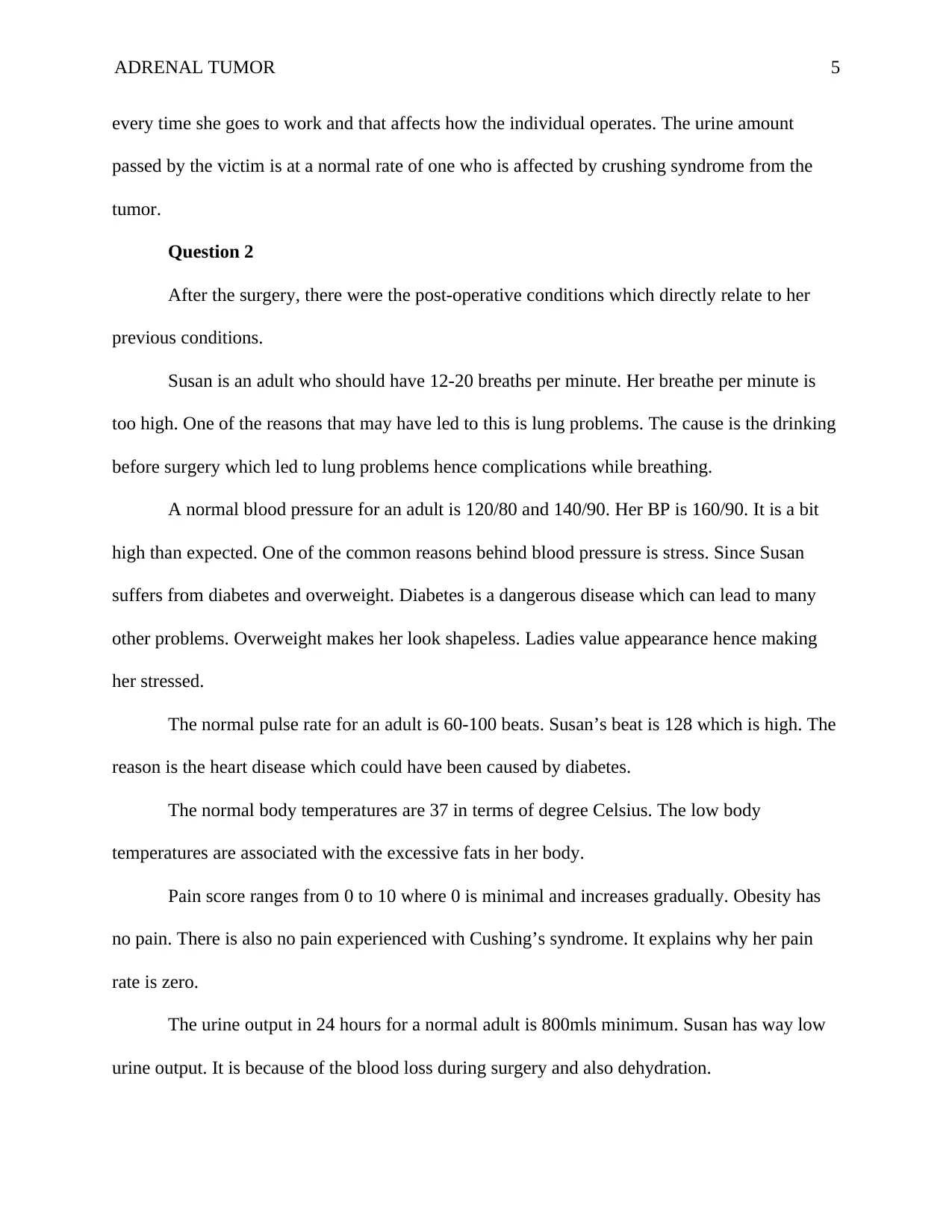
ADRENAL TUMOR 5
every time she goes to work and that affects how the individual operates. The urine amount
passed by the victim is at a normal rate of one who is affected by crushing syndrome from the
tumor.
Question 2
After the surgery, there were the post-operative conditions which directly relate to her
previous conditions.
Susan is an adult who should have 12-20 breaths per minute. Her breathe per minute is
too high. One of the reasons that may have led to this is lung problems. The cause is the drinking
before surgery which led to lung problems hence complications while breathing.
A normal blood pressure for an adult is 120/80 and 140/90. Her BP is 160/90. It is a bit
high than expected. One of the common reasons behind blood pressure is stress. Since Susan
suffers from diabetes and overweight. Diabetes is a dangerous disease which can lead to many
other problems. Overweight makes her look shapeless. Ladies value appearance hence making
her stressed.
The normal pulse rate for an adult is 60-100 beats. Susan’s beat is 128 which is high. The
reason is the heart disease which could have been caused by diabetes.
The normal body temperatures are 37 in terms of degree Celsius. The low body
temperatures are associated with the excessive fats in her body.
Pain score ranges from 0 to 10 where 0 is minimal and increases gradually. Obesity has
no pain. There is also no pain experienced with Cushing’s syndrome. It explains why her pain
rate is zero.
The urine output in 24 hours for a normal adult is 800mls minimum. Susan has way low
urine output. It is because of the blood loss during surgery and also dehydration.
every time she goes to work and that affects how the individual operates. The urine amount
passed by the victim is at a normal rate of one who is affected by crushing syndrome from the
tumor.
Question 2
After the surgery, there were the post-operative conditions which directly relate to her
previous conditions.
Susan is an adult who should have 12-20 breaths per minute. Her breathe per minute is
too high. One of the reasons that may have led to this is lung problems. The cause is the drinking
before surgery which led to lung problems hence complications while breathing.
A normal blood pressure for an adult is 120/80 and 140/90. Her BP is 160/90. It is a bit
high than expected. One of the common reasons behind blood pressure is stress. Since Susan
suffers from diabetes and overweight. Diabetes is a dangerous disease which can lead to many
other problems. Overweight makes her look shapeless. Ladies value appearance hence making
her stressed.
The normal pulse rate for an adult is 60-100 beats. Susan’s beat is 128 which is high. The
reason is the heart disease which could have been caused by diabetes.
The normal body temperatures are 37 in terms of degree Celsius. The low body
temperatures are associated with the excessive fats in her body.
Pain score ranges from 0 to 10 where 0 is minimal and increases gradually. Obesity has
no pain. There is also no pain experienced with Cushing’s syndrome. It explains why her pain
rate is zero.
The urine output in 24 hours for a normal adult is 800mls minimum. Susan has way low
urine output. It is because of the blood loss during surgery and also dehydration.
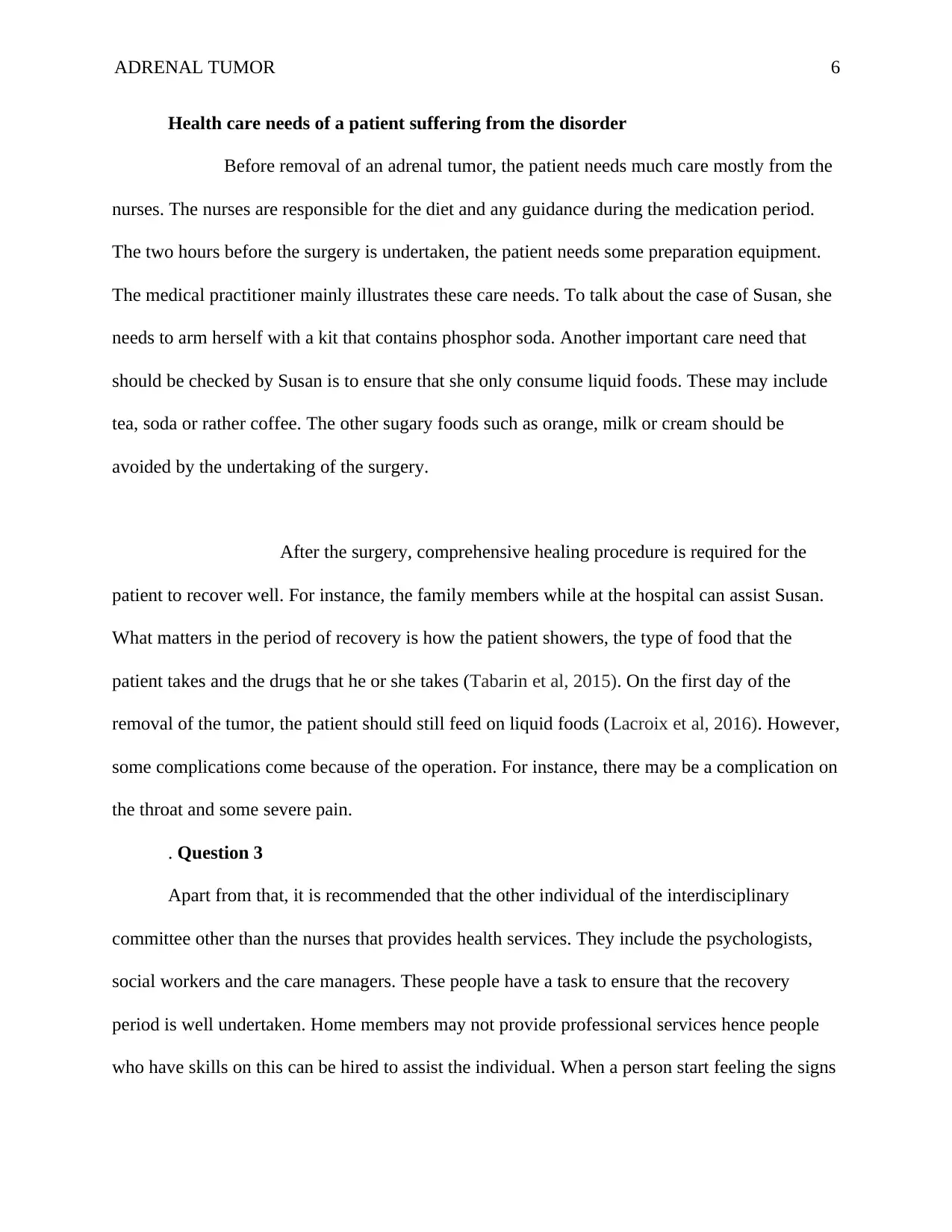
ADRENAL TUMOR 6
Health care needs of a patient suffering from the disorder
Before removal of an adrenal tumor, the patient needs much care mostly from the
nurses. The nurses are responsible for the diet and any guidance during the medication period.
The two hours before the surgery is undertaken, the patient needs some preparation equipment.
The medical practitioner mainly illustrates these care needs. To talk about the case of Susan, she
needs to arm herself with a kit that contains phosphor soda. Another important care need that
should be checked by Susan is to ensure that she only consume liquid foods. These may include
tea, soda or rather coffee. The other sugary foods such as orange, milk or cream should be
avoided by the undertaking of the surgery.
After the surgery, comprehensive healing procedure is required for the
patient to recover well. For instance, the family members while at the hospital can assist Susan.
What matters in the period of recovery is how the patient showers, the type of food that the
patient takes and the drugs that he or she takes (Tabarin et al, 2015). On the first day of the
removal of the tumor, the patient should still feed on liquid foods (Lacroix et al, 2016). However,
some complications come because of the operation. For instance, there may be a complication on
the throat and some severe pain.
. Question 3
Apart from that, it is recommended that the other individual of the interdisciplinary
committee other than the nurses that provides health services. They include the psychologists,
social workers and the care managers. These people have a task to ensure that the recovery
period is well undertaken. Home members may not provide professional services hence people
who have skills on this can be hired to assist the individual. When a person start feeling the signs
Health care needs of a patient suffering from the disorder
Before removal of an adrenal tumor, the patient needs much care mostly from the
nurses. The nurses are responsible for the diet and any guidance during the medication period.
The two hours before the surgery is undertaken, the patient needs some preparation equipment.
The medical practitioner mainly illustrates these care needs. To talk about the case of Susan, she
needs to arm herself with a kit that contains phosphor soda. Another important care need that
should be checked by Susan is to ensure that she only consume liquid foods. These may include
tea, soda or rather coffee. The other sugary foods such as orange, milk or cream should be
avoided by the undertaking of the surgery.
After the surgery, comprehensive healing procedure is required for the
patient to recover well. For instance, the family members while at the hospital can assist Susan.
What matters in the period of recovery is how the patient showers, the type of food that the
patient takes and the drugs that he or she takes (Tabarin et al, 2015). On the first day of the
removal of the tumor, the patient should still feed on liquid foods (Lacroix et al, 2016). However,
some complications come because of the operation. For instance, there may be a complication on
the throat and some severe pain.
. Question 3
Apart from that, it is recommended that the other individual of the interdisciplinary
committee other than the nurses that provides health services. They include the psychologists,
social workers and the care managers. These people have a task to ensure that the recovery
period is well undertaken. Home members may not provide professional services hence people
who have skills on this can be hired to assist the individual. When a person start feeling the signs
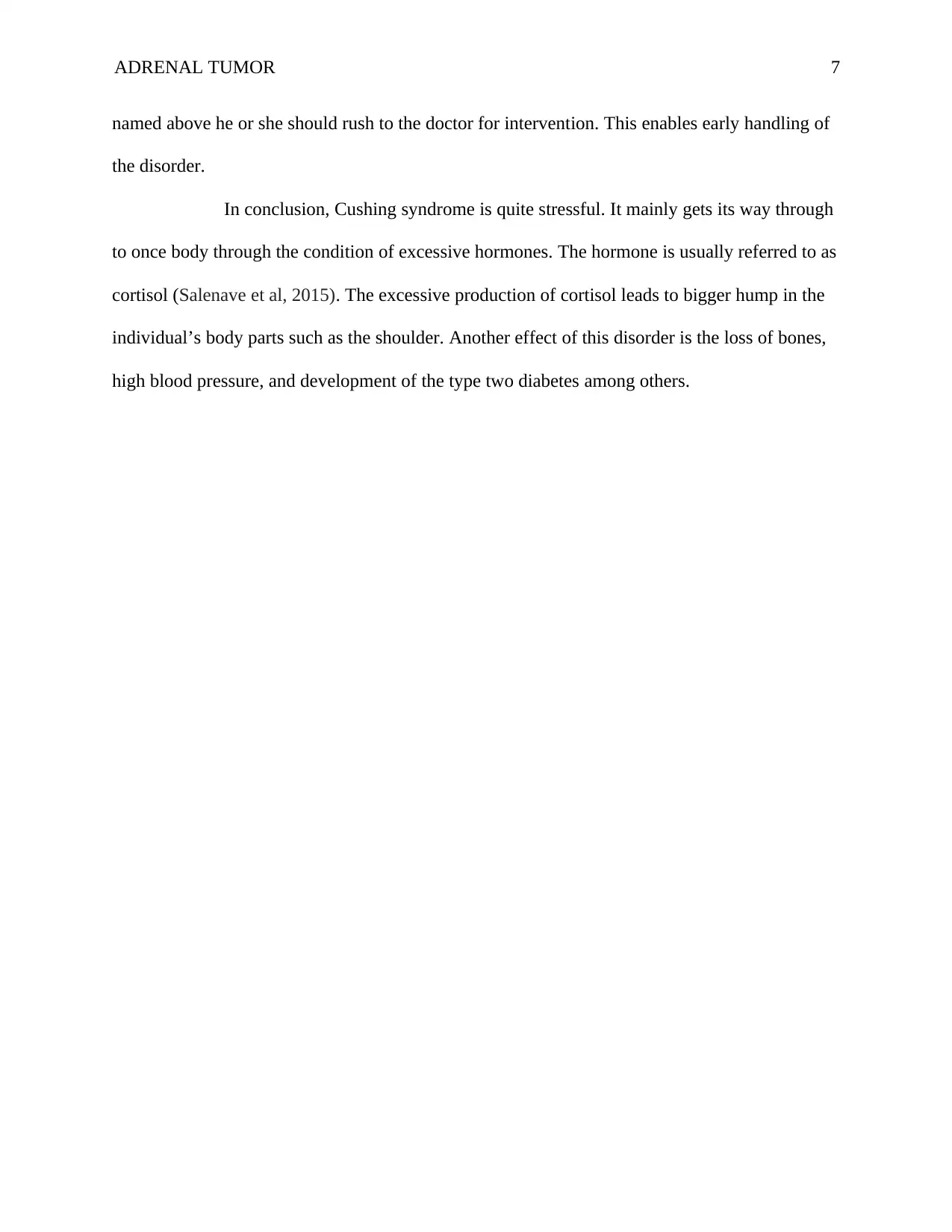
ADRENAL TUMOR 7
named above he or she should rush to the doctor for intervention. This enables early handling of
the disorder.
In conclusion, Cushing syndrome is quite stressful. It mainly gets its way through
to once body through the condition of excessive hormones. The hormone is usually referred to as
cortisol (Salenave et al, 2015). The excessive production of cortisol leads to bigger hump in the
individual’s body parts such as the shoulder. Another effect of this disorder is the loss of bones,
high blood pressure, and development of the type two diabetes among others.
named above he or she should rush to the doctor for intervention. This enables early handling of
the disorder.
In conclusion, Cushing syndrome is quite stressful. It mainly gets its way through
to once body through the condition of excessive hormones. The hormone is usually referred to as
cortisol (Salenave et al, 2015). The excessive production of cortisol leads to bigger hump in the
individual’s body parts such as the shoulder. Another effect of this disorder is the loss of bones,
high blood pressure, and development of the type two diabetes among others.
Paraphrase This Document
Need a fresh take? Get an instant paraphrase of this document with our AI Paraphraser
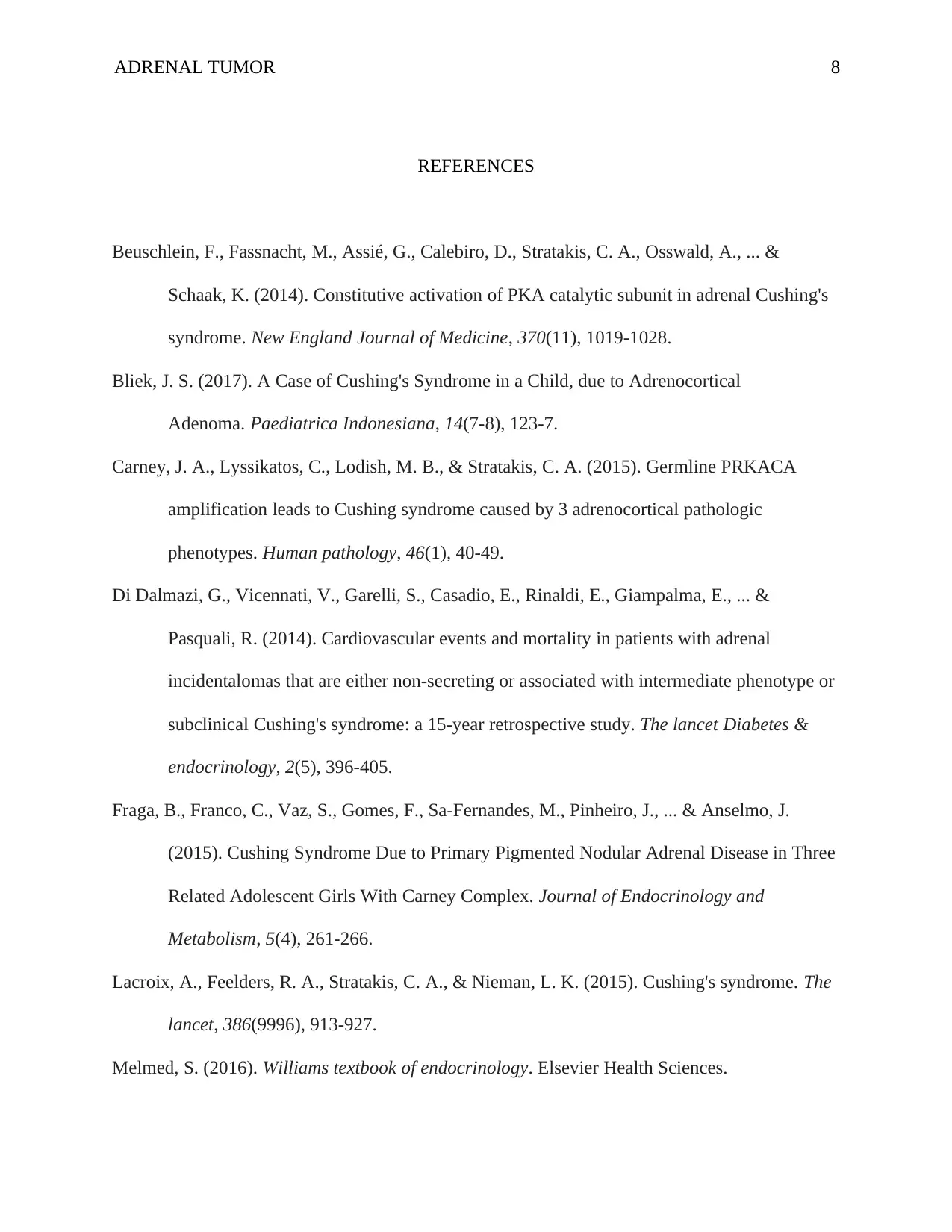
ADRENAL TUMOR 8
REFERENCES
Beuschlein, F., Fassnacht, M., Assié, G., Calebiro, D., Stratakis, C. A., Osswald, A., ... &
Schaak, K. (2014). Constitutive activation of PKA catalytic subunit in adrenal Cushing's
syndrome. New England Journal of Medicine, 370(11), 1019-1028.
Bliek, J. S. (2017). A Case of Cushing's Syndrome in a Child, due to Adrenocortical
Adenoma. Paediatrica Indonesiana, 14(7-8), 123-7.
Carney, J. A., Lyssikatos, C., Lodish, M. B., & Stratakis, C. A. (2015). Germline PRKACA
amplification leads to Cushing syndrome caused by 3 adrenocortical pathologic
phenotypes. Human pathology, 46(1), 40-49.
Di Dalmazi, G., Vicennati, V., Garelli, S., Casadio, E., Rinaldi, E., Giampalma, E., ... &
Pasquali, R. (2014). Cardiovascular events and mortality in patients with adrenal
incidentalomas that are either non-secreting or associated with intermediate phenotype or
subclinical Cushing's syndrome: a 15-year retrospective study. The lancet Diabetes &
endocrinology, 2(5), 396-405.
Fraga, B., Franco, C., Vaz, S., Gomes, F., Sa-Fernandes, M., Pinheiro, J., ... & Anselmo, J.
(2015). Cushing Syndrome Due to Primary Pigmented Nodular Adrenal Disease in Three
Related Adolescent Girls With Carney Complex. Journal of Endocrinology and
Metabolism, 5(4), 261-266.
Lacroix, A., Feelders, R. A., Stratakis, C. A., & Nieman, L. K. (2015). Cushing's syndrome. The
lancet, 386(9996), 913-927.
Melmed, S. (2016). Williams textbook of endocrinology. Elsevier Health Sciences.
REFERENCES
Beuschlein, F., Fassnacht, M., Assié, G., Calebiro, D., Stratakis, C. A., Osswald, A., ... &
Schaak, K. (2014). Constitutive activation of PKA catalytic subunit in adrenal Cushing's
syndrome. New England Journal of Medicine, 370(11), 1019-1028.
Bliek, J. S. (2017). A Case of Cushing's Syndrome in a Child, due to Adrenocortical
Adenoma. Paediatrica Indonesiana, 14(7-8), 123-7.
Carney, J. A., Lyssikatos, C., Lodish, M. B., & Stratakis, C. A. (2015). Germline PRKACA
amplification leads to Cushing syndrome caused by 3 adrenocortical pathologic
phenotypes. Human pathology, 46(1), 40-49.
Di Dalmazi, G., Vicennati, V., Garelli, S., Casadio, E., Rinaldi, E., Giampalma, E., ... &
Pasquali, R. (2014). Cardiovascular events and mortality in patients with adrenal
incidentalomas that are either non-secreting or associated with intermediate phenotype or
subclinical Cushing's syndrome: a 15-year retrospective study. The lancet Diabetes &
endocrinology, 2(5), 396-405.
Fraga, B., Franco, C., Vaz, S., Gomes, F., Sa-Fernandes, M., Pinheiro, J., ... & Anselmo, J.
(2015). Cushing Syndrome Due to Primary Pigmented Nodular Adrenal Disease in Three
Related Adolescent Girls With Carney Complex. Journal of Endocrinology and
Metabolism, 5(4), 261-266.
Lacroix, A., Feelders, R. A., Stratakis, C. A., & Nieman, L. K. (2015). Cushing's syndrome. The
lancet, 386(9996), 913-927.
Melmed, S. (2016). Williams textbook of endocrinology. Elsevier Health Sciences.
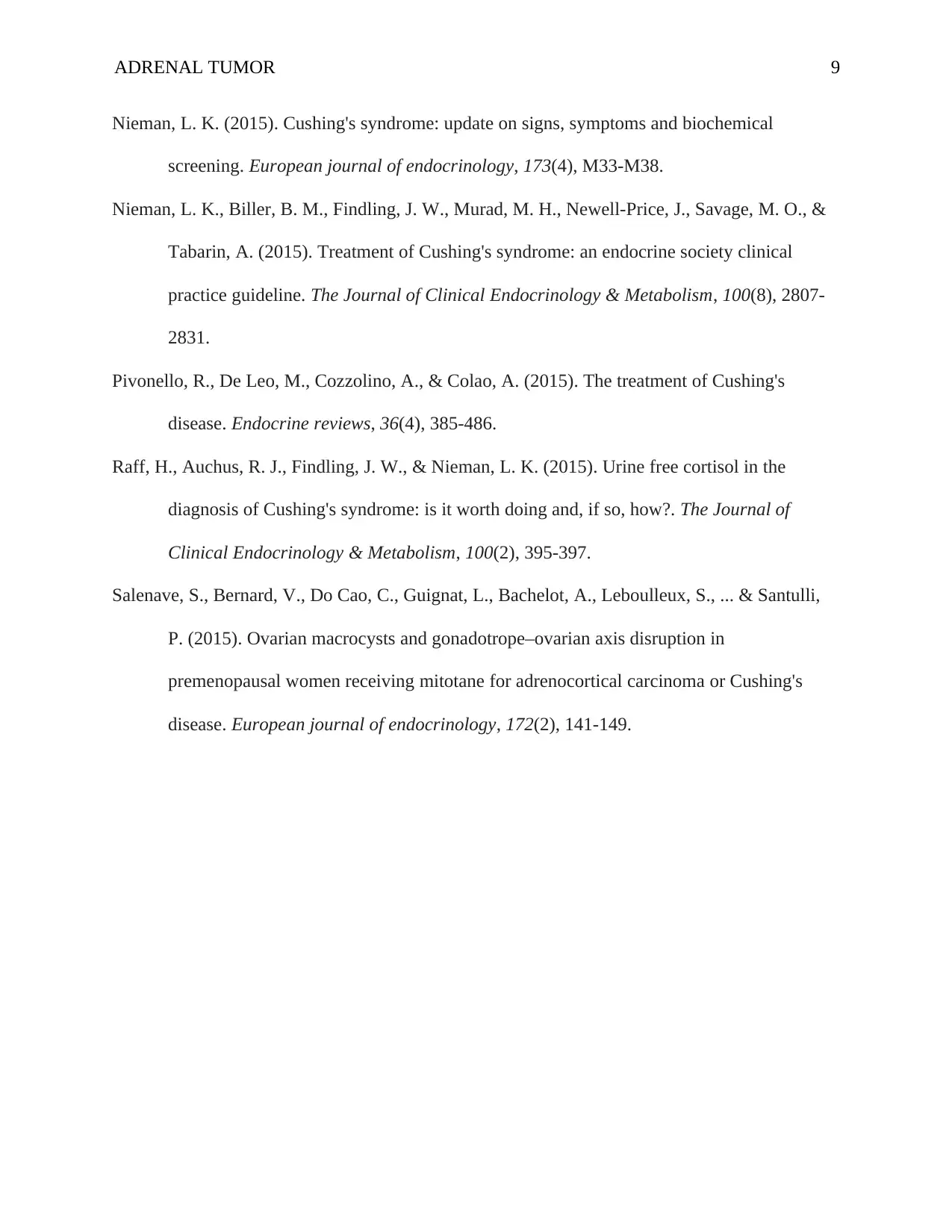
ADRENAL TUMOR 9
Nieman, L. K. (2015). Cushing's syndrome: update on signs, symptoms and biochemical
screening. European journal of endocrinology, 173(4), M33-M38.
Nieman, L. K., Biller, B. M., Findling, J. W., Murad, M. H., Newell-Price, J., Savage, M. O., &
Tabarin, A. (2015). Treatment of Cushing's syndrome: an endocrine society clinical
practice guideline. The Journal of Clinical Endocrinology & Metabolism, 100(8), 2807-
2831.
Pivonello, R., De Leo, M., Cozzolino, A., & Colao, A. (2015). The treatment of Cushing's
disease. Endocrine reviews, 36(4), 385-486.
Raff, H., Auchus, R. J., Findling, J. W., & Nieman, L. K. (2015). Urine free cortisol in the
diagnosis of Cushing's syndrome: is it worth doing and, if so, how?. The Journal of
Clinical Endocrinology & Metabolism, 100(2), 395-397.
Salenave, S., Bernard, V., Do Cao, C., Guignat, L., Bachelot, A., Leboulleux, S., ... & Santulli,
P. (2015). Ovarian macrocysts and gonadotrope–ovarian axis disruption in
premenopausal women receiving mitotane for adrenocortical carcinoma or Cushing's
disease. European journal of endocrinology, 172(2), 141-149.
Nieman, L. K. (2015). Cushing's syndrome: update on signs, symptoms and biochemical
screening. European journal of endocrinology, 173(4), M33-M38.
Nieman, L. K., Biller, B. M., Findling, J. W., Murad, M. H., Newell-Price, J., Savage, M. O., &
Tabarin, A. (2015). Treatment of Cushing's syndrome: an endocrine society clinical
practice guideline. The Journal of Clinical Endocrinology & Metabolism, 100(8), 2807-
2831.
Pivonello, R., De Leo, M., Cozzolino, A., & Colao, A. (2015). The treatment of Cushing's
disease. Endocrine reviews, 36(4), 385-486.
Raff, H., Auchus, R. J., Findling, J. W., & Nieman, L. K. (2015). Urine free cortisol in the
diagnosis of Cushing's syndrome: is it worth doing and, if so, how?. The Journal of
Clinical Endocrinology & Metabolism, 100(2), 395-397.
Salenave, S., Bernard, V., Do Cao, C., Guignat, L., Bachelot, A., Leboulleux, S., ... & Santulli,
P. (2015). Ovarian macrocysts and gonadotrope–ovarian axis disruption in
premenopausal women receiving mitotane for adrenocortical carcinoma or Cushing's
disease. European journal of endocrinology, 172(2), 141-149.
1 out of 9
Related Documents
Your All-in-One AI-Powered Toolkit for Academic Success.
+13062052269
info@desklib.com
Available 24*7 on WhatsApp / Email
![[object Object]](/_next/static/media/star-bottom.7253800d.svg)
Unlock your academic potential
© 2024 | Zucol Services PVT LTD | All rights reserved.





